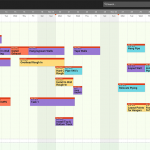(Hal Macomber, EVP, Touchplan with Calayde Davey, Ph.D., Research Associate, University of Pretoria, South Africa.) So, maybe the five big ideas are not so big anymore. (Did I say that?) 17 years ago we made a bold claim that the five big ideas would transform the industry. We had no idea that they would be adopted as one basis for the relational contract and delivery method that we now call Integrated Project Delivery. We also see evidence throughout the industry of giving high importance for collaboration and early trade contractor involvement for design assist to optimize the project as a whole. We also see those teams who use the Last Planner System® of Production Control use the name trade partners respectfully rather than subcontractors and they help the trades make reliable promises to other trades seeing each other as their customers.
While for many years we gave emphasis on bringing about the behaviors or practices of the five big ideas, we were always after something else. Our client-owners wanted solutions, not just practices. Specifically, they wanted more competitive projects, high-trust environments, reliability in outcomes, continuous improvement, and innovation. Each of these outcomes sit at the intersection of two of the five big ideas.
- Competitive solutions — really collaborate + optimize the project as a whole
- Continuous improvement — optimize the whole + couple learning with action
- Reliability of outcomes — couple learning with action + conduct projects as networks of commitments
- Building trust — conduct projects as networks of commitments + bring an outward mindset
- Innovation — bring an outward mindset + really collaborate
The above outcomes don’t just happen. And, if you’re not looking for them, then you may miss that they are available. While we claimed that the outcomes could be found at the intersection of the big ideas, we saw those intersecting practices as necessary conditions but not sufficient conditions. For instance, if you are looking for competitive solutions you need more than the intersecting actions of real collaboration and optimization of the whole project. We reasonably can expect that the timing of collaboration matters — neither too early nor too late — along with clear conditions of satisfaction and aspirational goals as targets for optimization. Miss any of those and you won’t have competitive solutions. Similarly, for the other four desired outcomes there are insufficient conditions that could prevent the outcomes from being realized.
Calayde points to the Eiffel Tower as an example of a client-owner who was (only) interested in a temporary gateway for an international exposition. Instead, the designers brought forth inspiration, ambition, with collaboration to design the tallest of all structures in the world (at that time) and an icon of possibility to this day. Our owner-clients deserve no less.
While our client-owners may be more focused on their business cases for their projects, the desired outcomes are central to the realization of their goals. The five big ideas practices are the building blocks for creating the conditions for realizing those desired outcomes.
We’d be remiss not to characterize our adoption of the five big ideas and the pursuit of the desired outcomes as ambitious. More appropriately, we’re speaking about profound change at a system level. But don’t be scared of that. You know the drill.
- Set a challenge.
- Grasp the current condition.
- Set an ambitious interim target condition.
- Experiment to learn what works better.
As you adopt change, look out for unintended consequences. Our best intentions invariably can lead to poor outcomes. Also, remember that we’re after improvement at the project level. Beware of improving locally at the expense of project-level improvements. If system (project) performance didn’t improve, then the change wasn’t effective.
Yes, the five big ideas are still transforming the design and construction industry. Adopt them to bring more value to your clients, your teams, and your company.
If you missed our last installment please read Project Production Thinking Behind the Five Big Ideas. Additionally, to see some collaboration and client solutions you can read Building a Partnership for Today and Beyond.
If you would like to revisit any of the posts from the Revisiting the Five Big Ideas series you can find all of them below.
- Part 1: Transforming the Design and Construction Industry
- Part 2: Collaborate; Really Collaborate
- Part 3: Tightly Couple Learning with Action
- Part 4: Optimize the Project as a Whole
- Part 5: Conduct Construction Projects as a Network of Commitments
- Part 6: Bring an Outward Mindset to All Interactions
- Part 7: Project Production Thinking Behind the Five Big
- Part 8: Pursue Project Outcomes at the Intersection of the Five Big Ideas
- Part 9: Adopting the Five Big Ideas on Your CM/GC Projects
- Part 10: What Comes After The Five Big Ideas?










